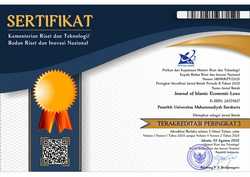Market Opportunities for Islamic Banking and Finance in Europe: A Case of Finnish Regulatory Framework
DOI:
https://doi.org/10.23917/jisel.v8i01.7229Keywords:
Islamic banking and finance, legal framework, Finland, riba, financial behaviour.Abstract
This article assesses market opportunities for Islamic banking and finance (IBF) in Finland, offering an understanding of the legal environment, consumer perceptions, and potential challenges and opportunities for developing Islamic finance within the Finnish legal framework. The study employs a survey to investigate the perceptions and behaviours of Muslims towards IBF in Finland, focusing on its legal dimensions. Utilizing a mixed-methods approach, including quantitative survey data and qualitative analysis, the research aims to understand Finnish Muslims' attitudes, preferences, and experiences towards Islamic banking products and services. The findings show that although a significant proportion of respondents revealed uncertainty or lack of knowledge about IBF, most respondents express their willingness to become customers of an Islamic financial institution if such institutions were available in Finland. This research contributes to the existing body of knowledge in Islamic finance law by elucidating the legal intricacies of Islamic banking within the European context. The insights generated offer valuable implications for policymakers, legal practitioners, and scholars interested in Islamic finance law.
Downloads
References
Agustin, F., Muhtadi, R., & Sahal, S. (2023). The Importance of Implementing Environment, Social and Government (ESG) and Maqasid Sharia-Based Islamic Finance in Islamic Bank. JISEL Journal of Islamic Economic Laws VI, 6(2), 133–158. https://journals.ums.ac.id/index.php/jisel/index
Ahmed, S. S. (2023). Kirjallinen kysymys KK 828/2022 vp. Eduskunta. https://www.eduskunta.fi/FI/vaski/Kysymys/Documents/KK_828+2022.pdf
Akbar, S., Zulfiqar Ali Shah, S., & Kalmadi, S. (2012). An investigation of user perceptions of Islamic banking practices in the United Kingdom. International Journal of Islamic and Middle Eastern Finance and Management, 5(4), 353–370. https://doi.org/10.1108/17538391211282845
Alharbi, A. (2016). Development of Islamic Finance in Europe and North America: Opportunities and Challenges. International Journal of Islamic Economics and Finance Studies, 2(3), 109–136. http://ijisef.org/
Alwazna, R. Y. (2016). Islamic Law: Its Sources, Interpretation and the Translation of It into Laws Written in English. International Journal for the Semiotics of Law, 29(2), 251–260. https://doi.org/10.1007/s11196-016-9473-x
Antoniazzi, S. (2022). Islamic Banks and the European Banking Union: An Overview of Critical Issues and Perspectives. European Journal of Islamic Finance, 9(1), 37–55. https://doi.org/10.13135/2421-2172/6424
Aqib Ali, M. (2023). An Assessment of Islamic Banking in Asia, Europe, USA, and Australia. European Journal of Islamic Finance, 10(1), 1–15. https://doi.org/10.13135/2421-2172/7345
Bananuka, J., Kaawaase, T. K., Kasera, M., & Nalukenge, I. (2019). Determinants of the intention to adopt Islamic banking in a non-Islamic developing country. ISRA International Journal of Islamic Finance, 11(2), 166–186. https://doi.org/10.1108/IJIF-04-2018-0040
Bananuka, J., Kasera, M., Najjemba, G. M., Musimenta, D., Ssekiziyivu, B., & Kimuli, S. N. L. (2019). Attitude: mediator of subjective norm, religiosity and intention to adopt Islamic banking. Journal of Islamic Marketing, 11(1), 81–96. https://doi.org/10.1108/JIMA-02-2018-0025
Belwal, R., & Al Maqbali, A. (2019). A study of customers’ perception of Islamic banking in Oman. Journal of Islamic Marketing, 10(1), 150–167. https://doi.org/10.1108/JIMA-02-2016-0008
Biancone, P. P., Saiti, B., Petricean, D., & Chmet, F. (2020). The bibliometric analysis of Islamic banking and finance. Journal of Islamic Accounting and Business Research, 11(9), 2069–2086. https://doi.org/10.1108/JIABR-08-2020-0235
Calandra, D., Marseglia, R., Vaccaro, V., & Chmet, F. (2022). Mapping Islamic finance and new technologies: research and managerial perspectives. European Journal of Islamic Finance, 9(1), 39–47. https://doi.org/10.13135/2421-2172/6257
di Mauro, F., Caristi, P., Couderc, S., Di Maria, A., Ho, L., Kaur Grewal, B., Masciantonio, S., Ongena, S., & Zaher, S. (2013). Occasional Paper Series No 146 / June 2013 Islamic Finance in Europe. https://www.ecb.europa.eu/pub/pdf/scpops/ecbocp146.pdf
Hanska, J. (2023, March 16). Vasemmistoliiton kansanedustaja toivoo islamilaista pankkia Suomeen – Tavallinen asuntolaina on nyt uskonoppien vastainen. Iltalehti. https://www.iltalehti.fi/politiikka/a/e67f32e1-cbf4-4c90-84c7-600640cfef07
Hassan, M. K., & Aliyu, S. (2018). A Contemporary Survey of Islamic Banking Literature. Journal of Financial Stability, 34, 12–43. https://doi.org/10.1016/j.jfs.2017.11.006
Iqbal, Z., & Mirakhor, A. (2007). An Introduction to Islamic Finance: Theory and Practice (2nd ed.). John Wiley & Sons.
Islam, J. U., & Rahman, Z. (2017). Awareness and willingness towards Islamic banking among Muslims: An Indian perspective. International Journal of Islamic and Middle Eastern Finance and Management, 10(1), 92–101. https://doi.org/10.1108/IMEFM-01-2016-0017
Jackson-Moore, E. (2009). The International Handbook of Islamic Banking and Finance. Global Professional Publishing.
Kaakeh, A., Hassan, M. K., & van Hemmen Almazor, S. F. (2018). Attitude of Muslim minority in Spain towards Islamic finance. International Journal of Islamic and Middle Eastern Finance and Management, 11(2), 213–230. https://doi.org/10.1108/IMEFM-11-2017-0306
Kadi, S. (2023). Implications for Islamic Finance Development in Finland: How Do Finnish Muslims Perceive Riba and Islamic Banking? European Journal of Islamic Finance, 10(1), 44–60. https://www.ojs.unito.it/index.php/EJIF/article/view/7162
Kamdzhalov, M. (2022). Evaluation of some key features of Islamic finance in non-Islamic economies: Bulgarian perspective. European Journal of Islamic Finance, 9(2), 9–17. https://doi.org/10.13135/2421-2172/6504
Kurochkina, I. G. (2021). Analysis of Newest Possibilities of Functioning of Islamic Finance in Europe. SHS Web of Conferences, 110(2), 01020, 1–5. https://doi.org/10.1051/shsconf/202111001020
Kuznetsov, A. V., Fituni, L. L., Ryzhkova, E. A., Trofimova, O. E., & Filonik, A. O. (2017). Islamic Finance and its Specifics in Europe. World Economy and International Relations, 61(12), 52–62. https://doi.org/10.20542/0131-2227-2017-61-12-52-62
Lanzara, F. (2021). Islamic Finance as Social Finance: A Bibliometric Analysis from 2000 to 2021. International Journal of Business and Management, 16(9), 107–128. https://doi.org/10.5539/ijbm.v16n9p107
Lumban Gaol, C. P. (2023). Normative Juridical Review Regarding Bank Interest in Islamic Law. Journal of Progressive Law and Legal Studies, 1(02), 66–74. https://doi.org/10.59653/jplls.v1i02.30
Minhas, I. H. (2022). Classical Islamic Principles and Present Islamic Banking. Islamic Banking and Finance Review, 8(2). https://doi.org/10.32350/ibfr/2021/08/2065
Muslichah, I., & Sanusi, S. (2019). The effect of religiosity and financial literacy on intention to use Islamic banking products. Asian Journal of Islamic Management (AJIM), 1(2), 85–92. https://doi.org/10.20885/ajim.vol1.iss2.art2
Narayan, P. K., & Phan, D. H. B. (2019). A survey of Islamic banking and finance literature: Issues, challenges and future directions. Pacific-Basin Finance Journal, 53, 484–496. https://doi.org/10.1016/j.pacfin.2017.06.006
Naser, K., Salem, A. Al, & Nuseibeh, R. (2013). Customers Awareness and Satisfaction of Islamic Banking Products and Services: Evidence from the Kuwait Finance House. International Journal of Marketing Studies, 5(6). https://doi.org/10.5539/ijms.v5n6p185
Oladapo, I. A., Hamoudah, M. M., Alam, Md. M., Olaopa, O. R., & Muda, R. (2022). Customers’ perceptions of FinTech adaptability in the Islamic banking sector: comparative study on Malaysia and Saudi Arabia. Journal of Modelling in Management, 17(4), 1241–1261. https://doi.org/10.1108/JM2-10-2020-0256
Rinne, M. (2023, March 25). Tästä syystä suomalaiset pankit ovat muslimeille arka paikka: “Suurin osa on hyvin uskovaisia ihmisiä.” Iltalehti. https://www.iltalehti.fi/kotimaa/a/216c004a-11e0-49dd-8890-c6c483fc7343
Saarikko, A. (2023). Vastaus kirjalliseen kysymykseen KKV 828/2022 vp. In Finnish Government. https://www.eduskunta.fi/FI/vaski/Kysymys/Documents/KKV_828+2022.pdf
Sain, M. R. M., Rahman, M. M., & Khanam, R. (2016). Financial Exclusion in Australia: Can Islamic Finance Minimise the Problem? Australasian Accounting, Business and Finance Journal, 10(3), 88–104. https://doi.org/10.14453/aabfj.v10i3.6
Shome, A., Jabeen, F., & Rajaguru, R. (2018). What drives consumer choice of Islamic banking services in the United Arab Emirates? International Journal of Islamic and Middle Eastern Finance and Management, 11(1), 79–95. https://doi.org/10.1108/IMEFM-03-2017-0066
Vogel, F. E., & Hayes, S. L. (1998). Islamic law and finance: religion, risk, and return. Kluwer Law International.
Zucchelli, D. (2022). Recent trend of deposits in Islamic banks. European Journal of Islamic Finance, 9(1), 56–64. https://doi.org/10.13135/2421-2172/6260

Submitted
Accepted
Published
How to Cite
Issue
Section
License
Copyright (c) 2024 Journal of Islamic Economic Laws

This work is licensed under a Creative Commons Attribution-ShareAlike 4.0 International License.

















